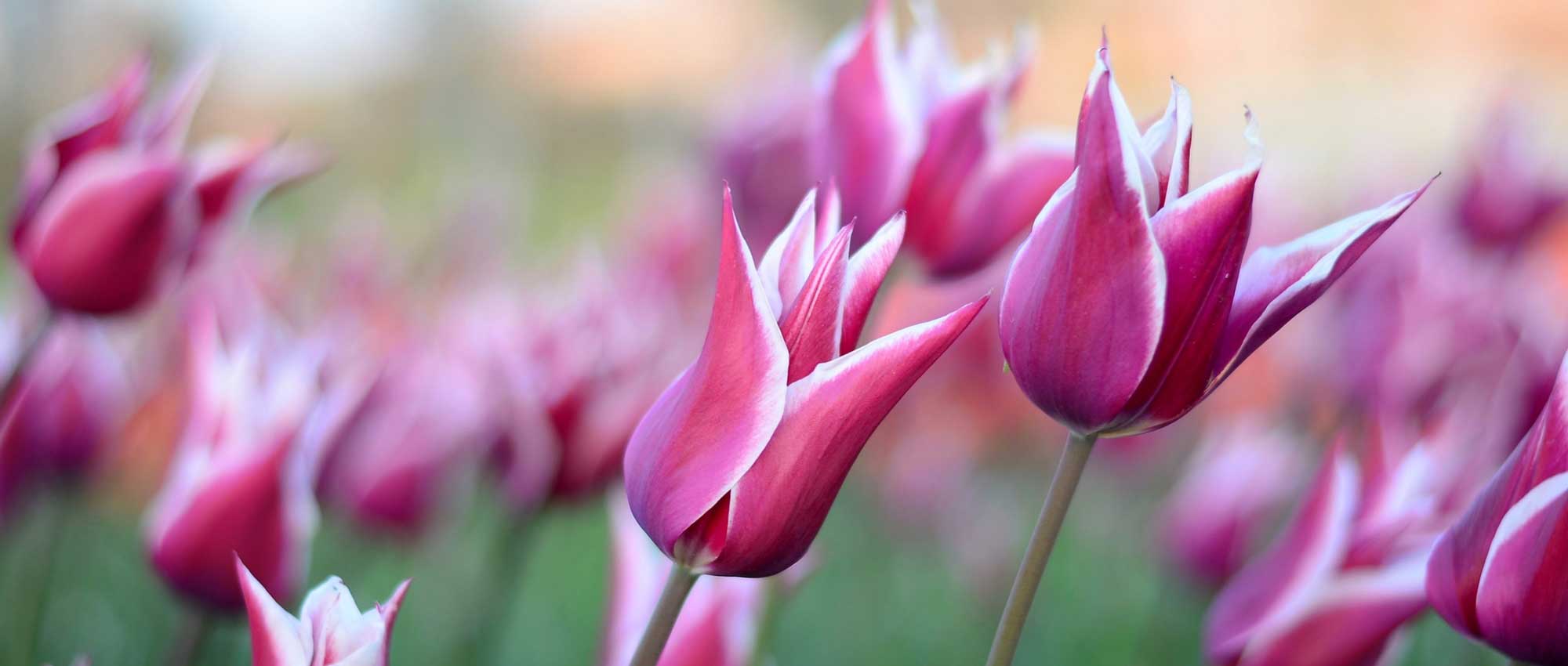
Tulips: planting, growing and care
Contents
Tulips in a nutshell
- Tulips offer a colourful flowering display throughout spring!
- They come in a wide range of colours
- They are easy-to-grow bulbous plants and low-maintenance
- They thrive in sunny, well-drained soils
- They are perfect for composing bouquets
- Some naturalise easily
A word from our Expert
The tulip is a stunning bulb that brings colour to spring with its bright flowering. It is a very elegant flower, standing tall towards the sky atop a sturdy stem. It captivates us with its simplicity and incredible delicacy. It offers a wide range of colours: there are black, white, yellow, red, orange, purple, and pink tulips… They can be solid, but also multicoloured, displaying beautiful patterns. The flowers come in different shapes; they are sometimes simple and cup-shaped, but at other times double, or with undulating, fringed petals, as seen in parrot tulips.
The tulip is an easy plant to grow and is not very demanding. The bulbs are planted in autumn, in sunny spots and in well-draining soil. They do not like excess moisture, which could cause them to rot. You can also grow them in pots and create beautiful arrangements by pairing them with other spring bulbs. Botanical tulips are the least demanding. They can grow in rockeries, require little maintenance, and can naturalise!
Botany
Botanical data
- Latin name Tulipa sp.
- Family Liliaceae
- Common name Tulip
- Flowering between March and May
- Height often between 20 and 60 cm
- Sun exposure sun
- Soil type light and draining
- Hardiness often around -15 °C
Tulips are bulbous plants that flower in spring, comprising nearly 120 species. They have been extensively hybridised, resulting in thousands of varieties with the most varied hues. Their centre of diversity is located in the steppes of Central Asia, particularly in Tajikistan and Kazakhstan. In France, a few species can be found in the wild, such as Tulipa sylvestris, Tulipa agenensis, or Tulipa clusiana. Tulips belong to the family Liliaceae, the family of the Lily, which also includes fritillaries, erythroniums, and tricyrtis. Most current varieties are derived from Tulipa x gesneriana. Cultivated tulips are classified into fifteen groups based on their characteristics (early singles, early doubles, triumph tulips, lily-flowered, etc.)
Most tulips measure between 20 and 60 centimetres in height. However, there are some exceptions, with tulips reaching 70-80 cm tall, while conversely, some tulips are very short, offering flowers almost at ground level, such as Tulipa humilis ‘Tête à Tête’, which measures between 6 and 10 cm in height. Botanical tulips are often smaller than horticultural varieties.
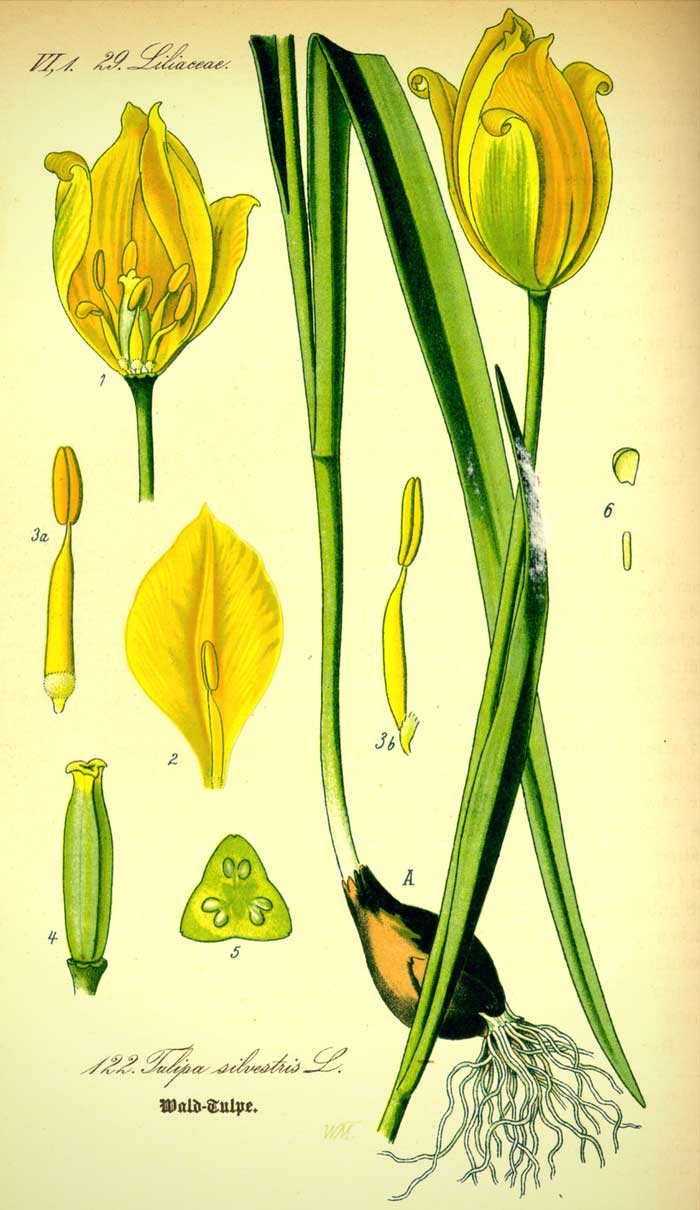 Tulipa sylvestris: botanical illustration[/caption>
Tulipa sylvestris: botanical illustration[/caption>
Tulips generally produce a long upright stem, which bears a large solitary flower at its tip. However, there are also multiflowering tulips, which have several flowers per stem, such as Tulipa praestans, and especially, like Tulipa turkestanica, where each stem bears between five and twelve flowers.
Depending on the various varieties, tulips bloom between March and May, and even until June for the later ones. The earliest bloomers are the botanical tulips, Tulipa kaufmanniana, and Tulipa fosteriana. The latest bloomers (around May) are the parrot tulips, viridiflora tulips, fringed tulips, and lily-flowered tulips… As for triumph tulips, they are mid-season varieties that bloom in the middle of spring.
Tulip flowers are upright towards the sky. In botanical species and most varieties, the flowers have three sepals and three petals. These six floral parts generally have the same colour and appearance, giving the impression of six coloured petals. They are also called tepals. At the centre of the flower, there are six stamens.
Tulips have been extensively hybridised, and instead of consistently presenting single flowers, some varieties now possess double flowers, or even very double flowers, depending on the number of petals. This is the case for peony-flowered tulips. Generally, these additional petals are obtained by transforming stamens into petals. Flowers can take various shapes: cup-shaped, goblet-shaped, ovoid, star-shaped… They can be very open, revealing the heart of the flower, sometimes of a different colour, but can also be much more closed. They have evolved so much that they sometimes resemble rose or peony flowers more than tulip flowers! Parrot tulips are original with their irregular, frilled petals… This gives the flower more volume. Triumph tulips have a very classic yet imposing side, with flowers that are slightly more squared than in other varieties.
Tulips offer a wide range of colours: they can be red, pink, white, golden yellow, purple – mauve, sometimes very dark, almost black, like the tulip ‘Black Hero’. The flowers are often solid-coloured but can also have multiple colours. Thus, Rembrandt tulips are surprising as they combine several bright colours, taking on a flamed appearance. The patterns they bear give the impression that they have been painted. Originally, these colours were obtained through a virus, but today, Rembrandt tulips are perfectly healthy. In viridiflora tulips, the outside of the petals is marked with green, making the flower even more delicate.
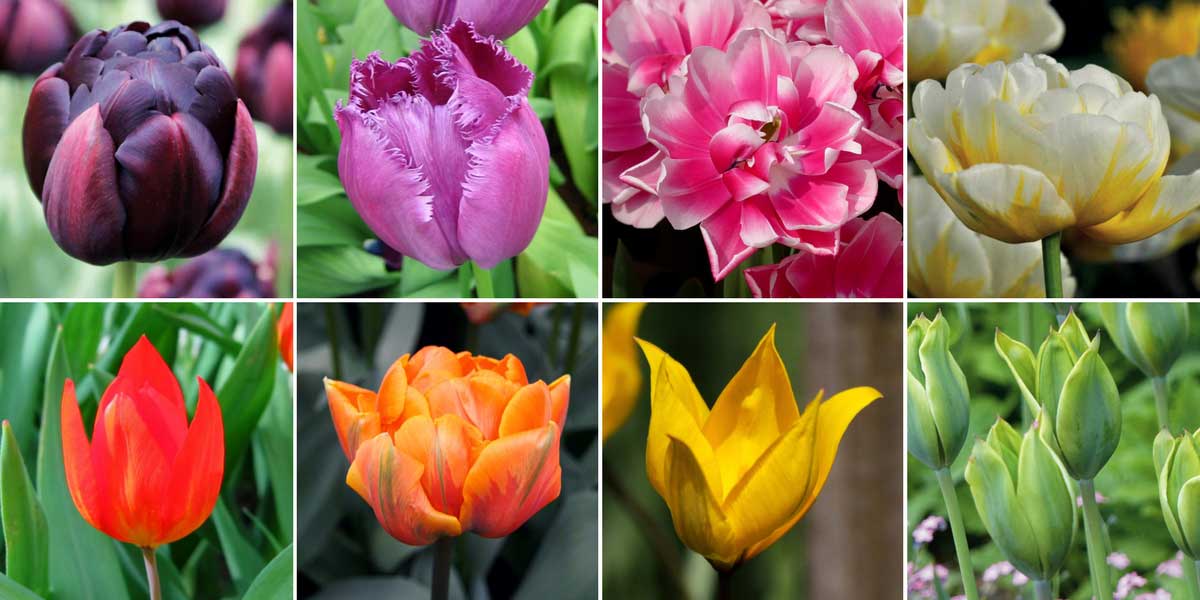
The different colours of tulip flowers with, in order, the varieties ‘Black Hero’ / ‘Curly Sue’ / ‘Columbus’ / ‘Flaming Evita’ / Tulipa praestans ‘Fusillier’ (photo: Leo Seta) / ‘Orange Princess’ / Tulipa sylvestris (photo: Björn S.) / ‘Evergreen’
The petals can be thin and tapered, sometimes pointed. This is generally the case with lily-flowered tulips, which gives them a very refined appearance. The Tulipa acuminata is impressive for its extremely fine petals! At other times, the petals are more rounded, coarser, as in the classic triumph tulips. They can also be fringed, with a laciniate edge. This then gives a flowering of rare finesse, with a lace-like appearance on the edges of the petals. Botanical tulips generally have more tapered and delicate petals than horticultural tulips.
[caption id="attachment_32075" align="alignright" width="1200"] The flowers of tulips can take very diverse shapes: Tulipa sylvestris (photo: Vadyum Manyuk) / lily-flowered tulip ‘Ballerina’ / parrot tulip ‘Flaming Parrot’ / Tulipa acuminata / early double tulip ‘Brownie’ (photo: Liz Every – GAP)
The flowers of tulips can take very diverse shapes: Tulipa sylvestris (photo: Vadyum Manyuk) / lily-flowered tulip ‘Ballerina’ / parrot tulip ‘Flaming Parrot’ / Tulipa acuminata / early double tulip ‘Brownie’ (photo: Liz Every – GAP)
Tulips have elongated leaves, pointed at the tip, and quite thick. Their edge is sometimes undulate. They are arranged alternately on the stems. They can be striated, striped… Thus, Tulipa greigii and Kaufmanniana tulips often have leaves marked with purple streaks.
Tulips possess bulbs, which serve as storage organs. They allow the plant to store nutrients to survive the bad season and bloom again in spring. Their size influences flowering: larger bulbs generally produce larger flowers. We recommend choosing bulbs that are at least calibre 12. Botanical tulips often have smaller bulbs than horticultural varieties.
The fruit of the tulip is an elongated capsule, which opens in three parts at maturity to release numerous brown, flattened seeds.
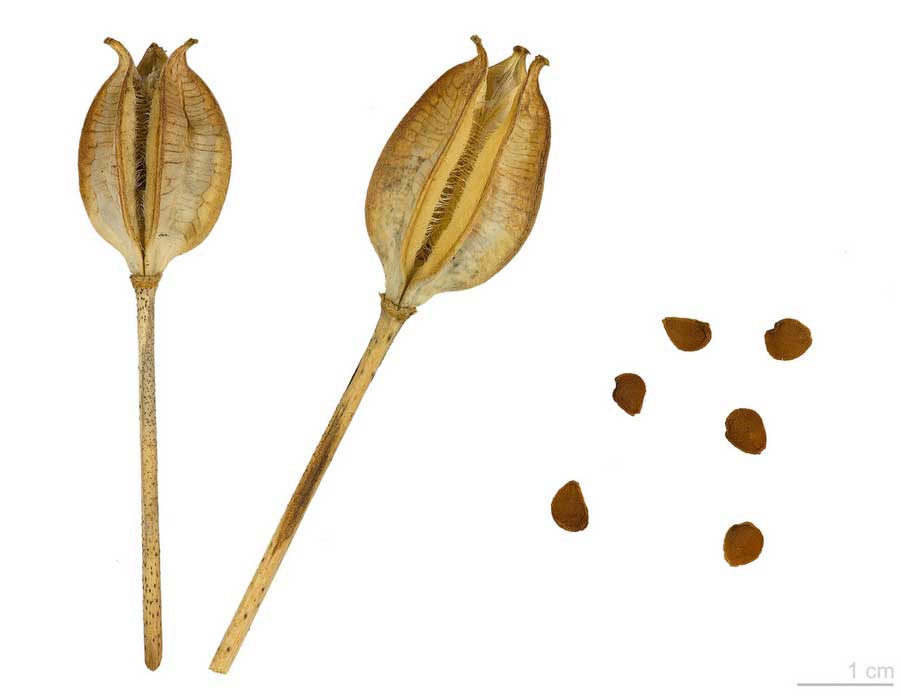 The capsules and seeds of Tulipa sylvestris (photo: Roger Culos – Museum de Toulouse)[/caption>
The capsules and seeds of Tulipa sylvestris (photo: Roger Culos – Museum de Toulouse)[/caption>
Botanical Tulips:
Most horticultural tulips are derived from Tulipa gesneriana. This species has been hybridised for centuries, resulting in a profusion of impressive varieties with large, colourful flowers. Botanical tulips are those that do not descend from Tulipa gesneriana. They are species found in the wild, or varieties that have remained very close to it, as they are weakly hybridised. They are less dependent on humans for their survival. Thus, they require less care, can manage on their own, and return year after year. They naturalise easily. They also offer more delicate, finer flowers…
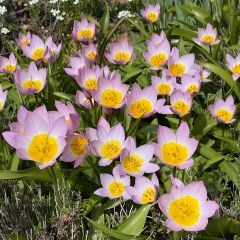
Tulipa bakeri Lilac Wonder
- Flowering time May
- Height at maturity 15 cm
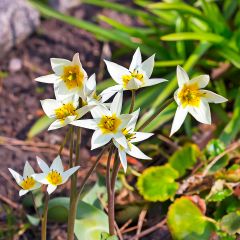
Tulipa turkestanica - Botanical Tulip
- Flowering time April, May
- Height at maturity 15 cm
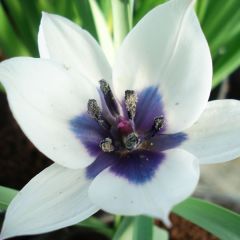
Tulipa Albocaerula Oculata Group
- Flowering time April
- Height at maturity 10 cm
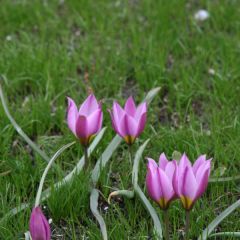
Tulipa humilis var. pulchella
- Flowering time April
- Height at maturity 15 cm
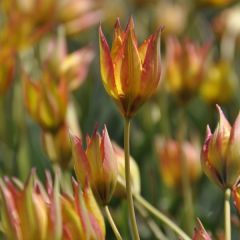
Tulipa orphanidea 'Flava'
- Flowering time May
- Height at maturity 20 cm
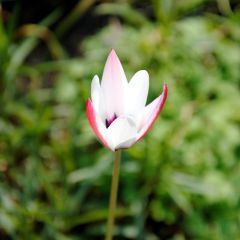
Tulipa clusiana 'Peppermintstick'
- Flowering time April, May
- Height at maturity 20 cm
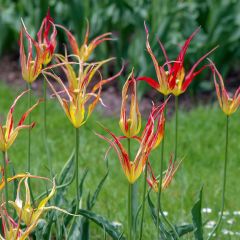
Tulipa acuminata
- Flowering time June, July
- Height at maturity 40 cm
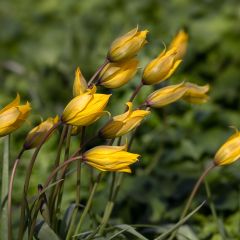
Tulipa sylvestris - Botanical Tulip
- Flowering time April, May
- Height at maturity 40 cm
The main varieties of tulips
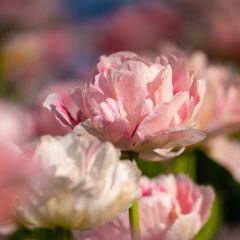
Tulipa Angélique - Double Late Tulip
- Flowering time May, June
- Height at maturity 40 cm
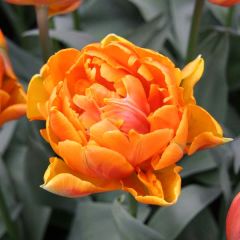
Tulipa Orange Princess - Double Late Tulip
- Flowering time May, June
- Height at maturity 35 cm

Tulipa fosteriana Purissima
- Flowering time April, May
- Height at maturity 40 cm
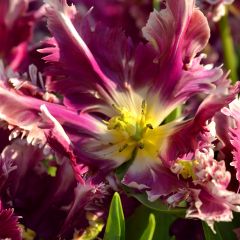
Tulipa Mysterious Parrot - Parrot Tulip
- Flowering time May, June
- Height at maturity 45 cm
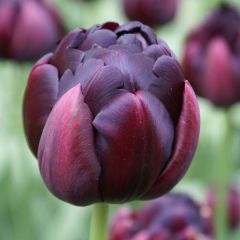
Tulipa Black Hero - Double Late Tulip
- Flowering time May, June
- Height at maturity 50 cm
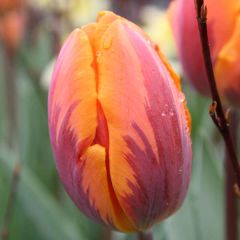
Tulipa Triumph Princesse Irene
- Flowering time May, June
- Height at maturity 35 cm

Tulipa Negrita - Triumph Tulip
- Flowering time May, June
- Height at maturity 45 cm
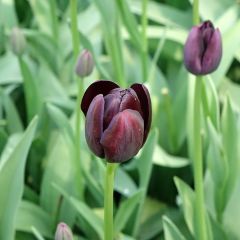
Tulipa Queen of the Night - Early simple Tulip
- Flowering time May, June
- Height at maturity 60 cm
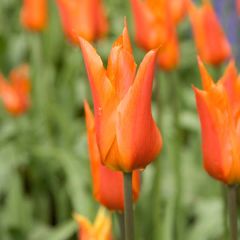
Tulipa Ballerina - Lily flowering Tulip
- Flowering time June
- Height at maturity 50 cm
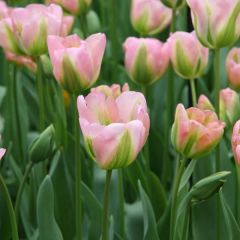
Tulipa viridiflora Greenland
- Flowering time May, June
- Height at maturity 45 cm
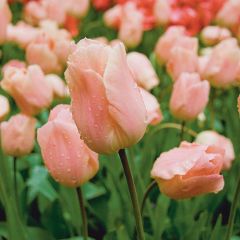
Tulipa Apricot Beauty
- Flowering time April, May
- Height at maturity 40 cm
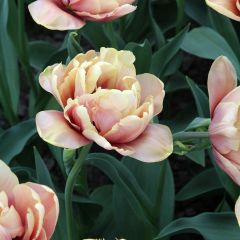
Tulipa La Belle Époque- Double Early Tulip
- Flowering time May, June
- Height at maturity 35 cm
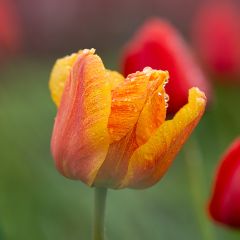
Tulipa Cairo
- Flowering time May, June
- Height at maturity 50 cm
Discover other Tulips
View all →Available in 1 sizes
Available in 0 sizes
Available in 1 sizes
Available in 1 sizes
Available in 1 sizes
Available in 1 sizes
Available in 1 sizes
Available in 1 sizes
Available in 1 sizes
Available in 1 sizes
Young plantation
Where to plant?
Tulips thrive in sunlight. They can tolerate partial shade, but ample brightness is necessary to ensure good flowering. It is best to plant them in a sheltered position from the wind, especially for the taller varieties.
Plant your tulips in light, well-draining soil. They do not like stagnant moisture, which can cause the bulbs to rot. If your soil is heavy, you should add a layer of gravel or coarse sand in each planting hole to allow for drainage. However, tulips appreciate rich, fertile soils. If your soil is poor, it is advisable to add compost. They are, however, not very sensitive to pH.
You can grow tulips in pots and place them on your terrace or windowsill. Pair them with other spring bulbs (daffodils, grape hyacinths, hyacinths…) and layer the bulbs by planting them at different depths. As they enjoy sunlight and well-draining soils, some tulips will particularly thrive in a rock garden! This is the case for most botanical tulips (Tulipa humilis, Tulipa polychroma, Tulipa turkestanica…).
Botanical tulips are the easiest to grow. They are less demanding and can tolerate more varied conditions than horticultural tulips. They will therefore more easily withstand a shaded position, heavy soil, or dry and poor terrain.

Botanical tulips easily settle in rock gardens. / Horticultural varieties are perfect for borders (photo MAP – Clive Nichols) / But you can also grow them in pots (photo: Friedrich Strauss – Biosphoto)
When to plant?
Tulip bulbs are preferably planted in autumn between October and November. A little earlier (in September) if you live in a region with a harsh climate. You can certainly plant them later, around December or even January, but the flowering may be less abundant and delayed by a few weeks.
You can also consult our advice sheet – Planting spring bulbs late
How to plant?
We recommend planting the bulbs in groups rather than individually. Allow about ten centimetres of space between each bulb.
Before planting, check the condition of your bulbs: they should be healthy, firm, and not show deep signs of mould. You can wipe them with a cloth to remove superficial mould, but if it does not come off, avoid planting the bulb. It may not take and could contaminate the other bulbs.
- Place your bulbs. You can scatter them randomly on the ground for a natural effect.
- Dig a planting hole for each bulb, between 12 and 15 centimetres deep. Botanical tulips are planted a little less deeply, but as a general rule, the bulb should be buried at a depth of twice its height. You can use a bulb planter.
- If your soil is heavy and clayey, you can add a thin layer of drainage at the bottom of the hole (gravel, coarse sand…).
- Place the bulb the right way up, with the point facing upwards.
- Cover it with soil, then firm it down.
- Water lightly.
You can add a layer of mulch to keep the soil cool, prevent weeds from growing, and protect the bulbs from the cold.
Discover our video tips: Planting tulip bulbs
Care
Generally, tulips can do without watering, especially if they are grown in the ground (in pots, the substrate dries out faster!). Water them mainly during spring droughts. Just after flowering, the bulb replenishes its reserves: we therefore recommend adding a bit of fertiliser and watering lightly at this time. Also, remove faded flowers to avoid unnecessarily exhausting the plant. Then, when the leaves start to dry, watering should be stopped; otherwise, the bulb may rot.
Do not cut the leaves until they are completely dry. Let them yellow and dry naturally. After flowering, the foliage allows the bulb to replenish its reserves for a good bloom the following spring. Be careful if you have planted them in a short grass meadow: you will need to wait until the foliage is dry before mowing.
It is customary to dig up the bulbs of horticultural varieties in summer, once the foliage has dried, to store them in a dark, dry place, and replant the best ones in autumn. However, today we rather advise leaving them in place, especially if your soil is well-drained. Whether you dig them up or not, the bulbs of horticultural tulips will degenerate after a few years. In any case, it is unnecessary to dig up those of botanical tulips, as they are self-sustaining plants that last a long time and can naturalise!
Tulips can do without fertiliser, as their bulb contains nutrient reserves. But you can also choose to add fertiliser to encourage beautiful flowering, especially if your soil is poor. In any case, prefer a fertiliser low in nitrogen.
Tulip bulbs are appreciated by rodents (voles, mice…)! To keep them away, you can plant repellent plants near your tulips: fritillaries, spurge, incarvillea… or surround the bulbs with wire mesh during planting. It also happens that squirrels dig them up. Finally, if you live in the countryside near a forest, it is possible that wild boars come to plough, dig up, and eat the bulbs.
Discover Virginie’s tips to protect the bulbs from rodents!
Tulips can be affected by “Tulip Fire” (Botrytis tulipae), a fungal disease that causes grey spots on leaves and flowers, and sometimes deforms the foliage. As soon as you notice this disease, remove the affected plants and avoid replanting tulips in the same spot. Tulips can also be attacked by aphids, bulb mites, or nematodes.
Also, discover our tips to make tulips bloom again.
Propagating
Tulips multiply by bulb division. Do this when the plant is dormant, once the foliage has turned yellow. We recommend dividing your tulips every three to four years.
- Dig up the bulbs. Dig wide enough to avoid damaging them.
- Gently separate the new bulbs that have developed around the original bulb. Check that they are healthy, firm, and free from disease marks.
- Choose a suitable location, in sunlight and well-draining soil.
- Dig holes 10 to 15 centimetres deep and place the new bulbs.
- Cover them with soil, firm down, and water.
It is advisable to prevent the plant from flowering in the first year by cutting the flower stem. This will allow the bulb to grow, build up its reserves, and provide more beautiful flowerings later on.
→ Also discover how to multiply bulbs by scaling in our tutorial!
Association
Tulips come in a wide range of colours and shapes… Feel free to mix different varieties! You can create harmonies by using varieties in the same tones… or create stunning contrasts! Discover our collections, which offer splendid combinations of different varieties.

Our bucolic collection combines ‘Burgundy’, ‘Spring Green’, ‘Blue Diamond’, and ‘Shirley’ tulips (photo: Pernilla Bergdahl – GAP Photos)
Create a colourful and vibrant flowerbed by combining horticultural tulips with spring-flowering perennials. The perennials will help to hide the tulip at the end of its growing cycle, concealing its yellowing leaves… You can plant them alongside hardy geraniums, Bleeding Hearts, hostas, or pansies.
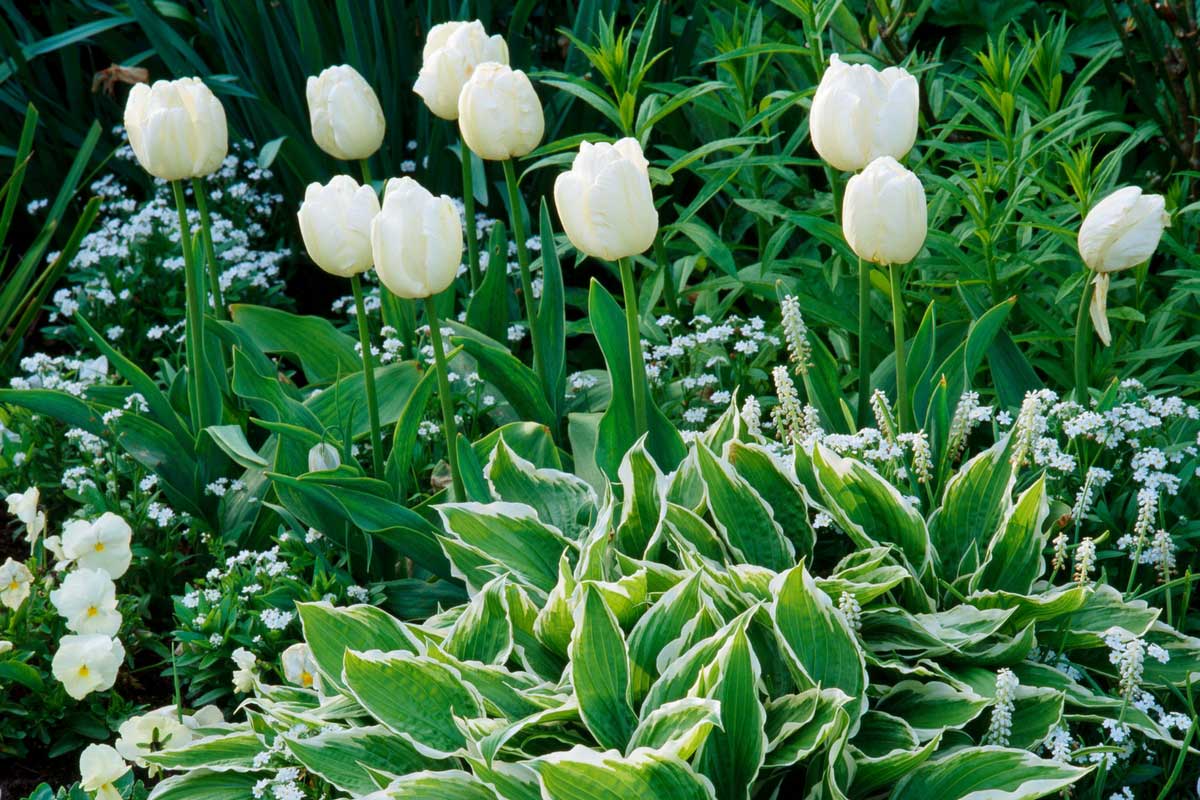
In a flowerbed, you can combine ‘Hibernia’ tulips with ‘Matrix White’ pansies and ‘Silver Crown’ hostas (photo: Clive Nichols – MAP)
Tulips pair perfectly with other spring-flowering bulbs, such as muscari, hyacinths, daffodils, fritillaries, or crocuses… Also enjoy the delicate blue or white flowers of ipheions.
Some tulips can be planted in rockeries! Preferably choose botanical tulips, such as the red and yellow flowering Tulipa schrenkii, the delicate little Tulipa humilis, the white and yellow flowering Tulipa polychroma, or the multiflorous Tulipa turkestanica. Plant them alongside other drought-tolerant plants.
Feel free to play with colours… And create a contrasting flowerbed, for example by combining black tulips (like Tulipa ‘Queen of Night’) and white tulips (like Tulipa ‘White Triumphator’). You can also achieve a harmonious scene by composing a flowerbed with warm tones, using carex, heucheras, erysimum, and euphorbia griffithii.
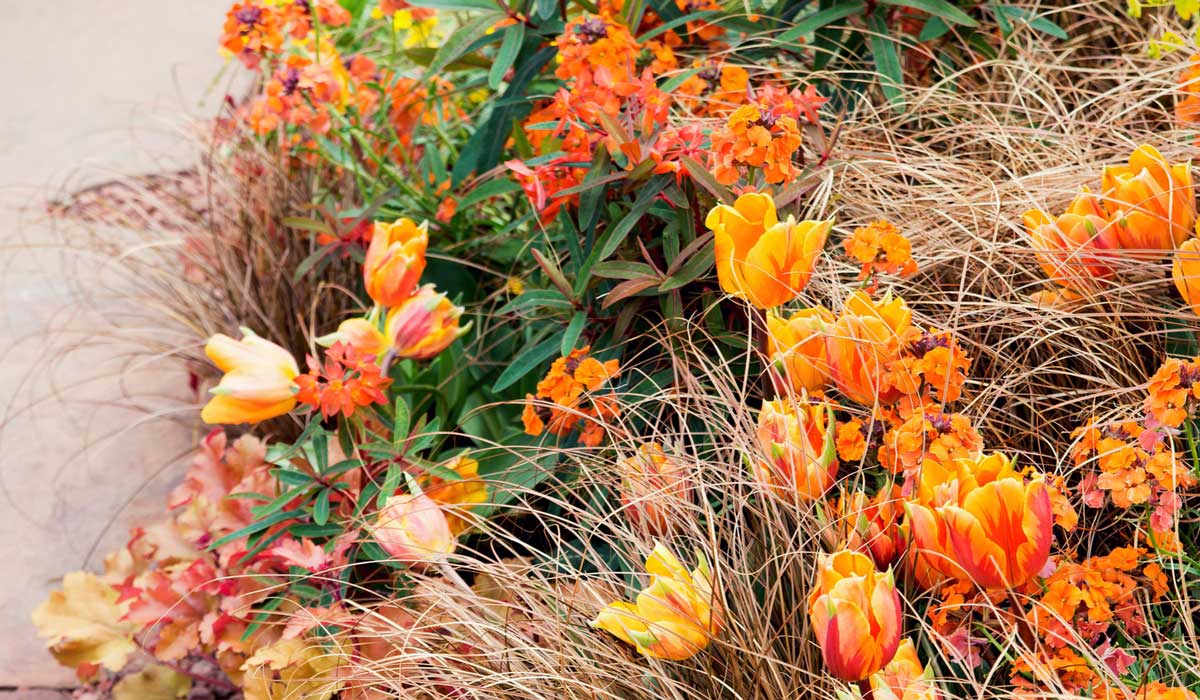
Create a warm-toned scene by combining ‘Irene’ tulip with ‘Chocolate’ Carex, ‘Marmalade’ Heuchera, ‘Poem Mandarine’ Erysimum, and ‘Dixter’ Euphorbia griffithii (photo: GAP – Heather Edwards – Design Gary Bristow)
Grow your tulips in pots and create a stunning spring composition in deep blue tones, for example by pairing ‘Queen of Night’ tulip with muscari and pansies.
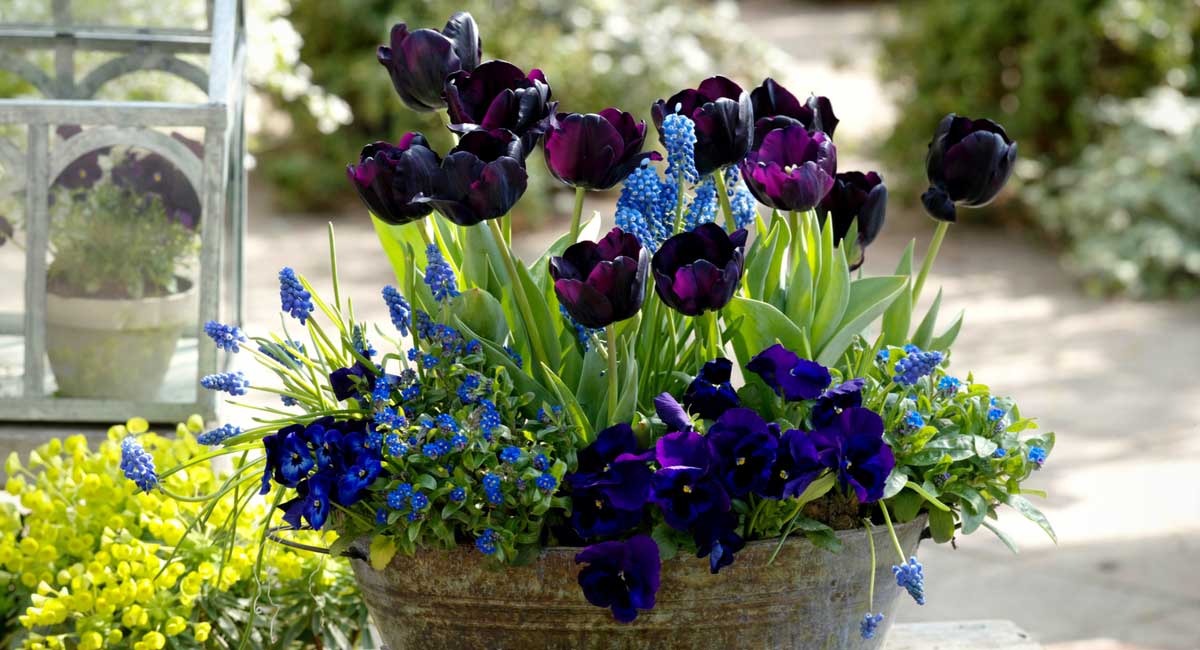
You can create a stunning deep blue composition by combining ‘Queen of Night’ tulip with muscari and pansies (photo: Friedrich Strauss – Biosphoto)
Botanical tulips easily find their place in a naturalistic garden, alongside other small spring bulbs (muscari, fritillaries…), or small early perennials. You can pair them with forget-me-nots, honesty (Lunaria), grasses, and especially the blue flowers of wood hyacinth (Hyacinthoides non-scripta)! Similarly, for a very natural look, don’t hesitate to scatter tulip bulbs in your short grass meadow.
Did you know?
- Tulipomania
In the 17th century in Holland, there was a genuine craze for the tulip. The price of tulip bulbs literally soared… a single bulb was worth up to fifteen times the annual salary of a craftsman! Some people gathered to buy a share of a bulb together. Then the price collapsed, leading to the ruin of many speculators. This event is sometimes referred to as the “first speculative bubble” in history.
- The Keukenhof Garden
In Holland, the Keukenhof floral park showcases an exceptional collection of tulips and spring plants, with a total of over 7 million bulbs. Discover Pierre’s article on our blog.
Useful resources
-
- Discover our wide range of tulips!
- Our Depth Guide for Spring Bulbs
- Advice sheet – How to Make My Tulips Bloom Again
- Advice sheet – How to Protect Bulbs from Rodents
- Advice sheet – Late Planting of Spring Bulbs
- Advice sheet – Tulips: What to Do When They Have Finished Flowering?
- Advice sheet – Diseases and Pests of Tulips
- An article by Pascal on our blog – How to Fail at Growing Tulips in 5 Lessons
- An article by Pierre – Tulips: How to Choose Them Well in 3 Points?
- Advice sheet: Which Bulbs to Grow Indoors?
- Advice sheet: Bulb Size: Understanding to Choose Better
- Advice sheet: 6 Bulbs to Naturalise in the Garden
- Article: Keukenhof: The Paradise of Flowering Bulbs
- Advice sheet: Tulips by Flowering Period
- Article: A Bouquet of Tulips for 1 Euro!
- Our advice sheets on different types of tulips: the parrot tulip, the fleur-de-lis tulip, the very double flowered tulips, the fringed tulip: a jewel for the garden, the viridiflora tulips: the most popular, 9 variegated leaf tulips
- Our advice sheets by tulip colour: 7 yellow flowering tulips, 7 red flowering tulips, 7 pink flowering tulips, 7 white flowering tulips, 6 purple, mauve or violet flowering tulips
- Discover the saga of tulipomania on our blog with Gwenaëlle
- Our tulip novelties for 2023!
Frequently asked questions
-
Should I remove the bulbs after flowering?
Traditionally, it was customary to remove bulbs once the foliage has yellowed, in order to keep them dry and replant the best ones in autumn. This operation is justified for double varieties and parrot tulips, but it is not essential for traditional horticultural varieties and is unnecessary for botanical tulips. The latter thrive in the garden and return each year without requiring intervention. If you dig up horticultural tulip bulbs, clean them to remove the soil, cut the foliage and roots, let them dry, and then store them in a dry, dark, and well-ventilated place.
-
My bulbs are not shooting, I can't find them.
Rodents (especially voles and mice) are fond of tulip bulbs, so there’s a good chance they have consumed them! Discover Virginie's tips for protecting bulbs from rodents. https://www.promessedefleurs.com/conseil-plantes-jardin/ficheconseil/comment-proteger-les-bulbes-des-rongeurs/ Otherwise, if your soil is heavy or if you didn’t sort them before planting, it’s possible that some bulbs have rotted due to moisture or mould that has developed. Tulips need to be grown in well-draining soil!
-
The flowering of my tulips is fading over time. What should I do?
We advise you to divide them. You can also add some fertiliser. Otherwise, it depends on the type of tulips you are growing, but while botanical tulips are perennial, this is not the case for horticultural varieties, which need to be replaced after a few years.
-
I forgot to plant my tulip bulbs this autumn... can I plant them late, or should I wait until the following autumn?
If you find your bulbs in December or January, it's best to plant them immediately. The flowering will just be delayed. After March, the result may be quite uncertain. However, tulips cannot wait a year before being planted... There's no point in keeping them for planting the following autumn. The reasonable planting period also depends on your climate: you can afford to plant them later if you live in the south of France.
- Subscribe!
- Contents
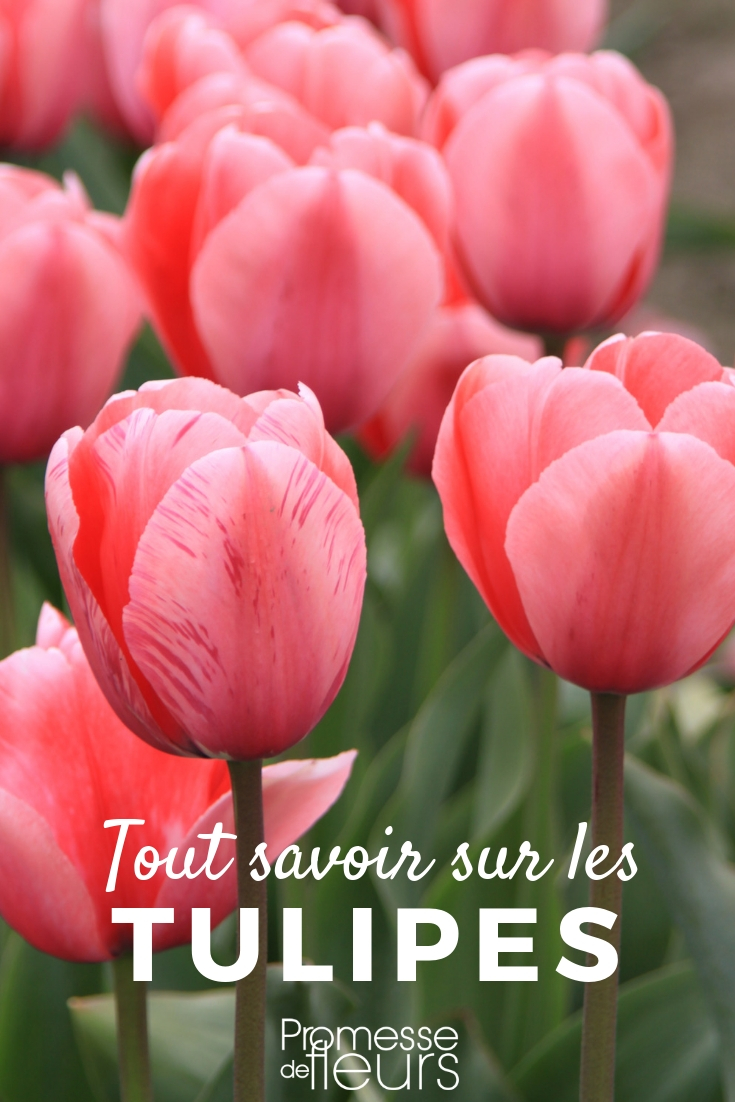































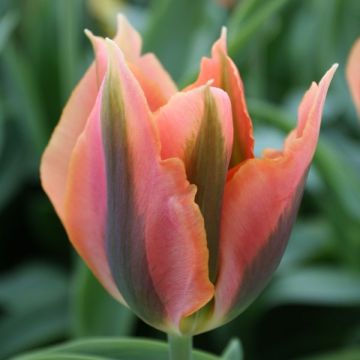
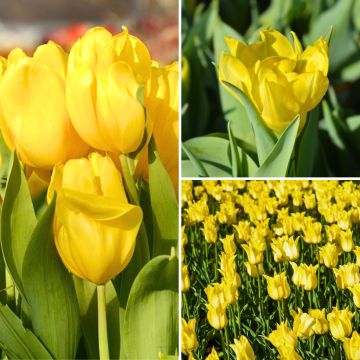
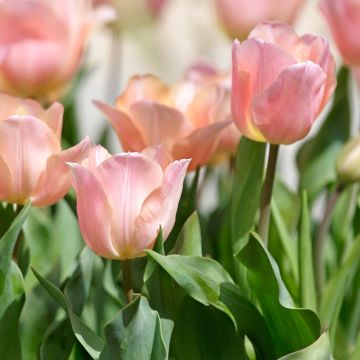

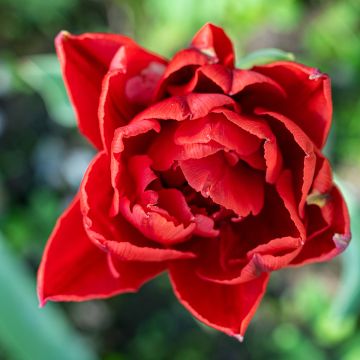
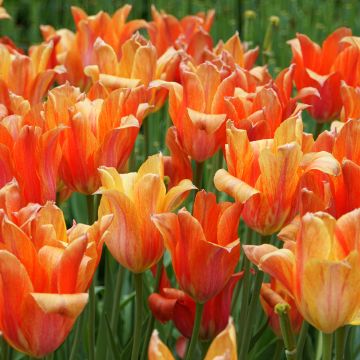
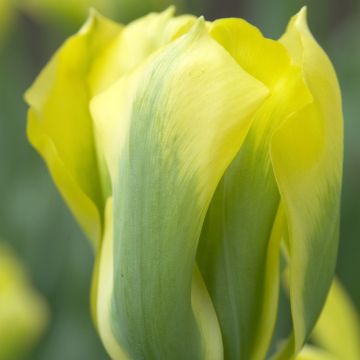
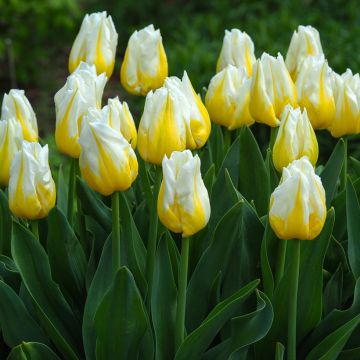
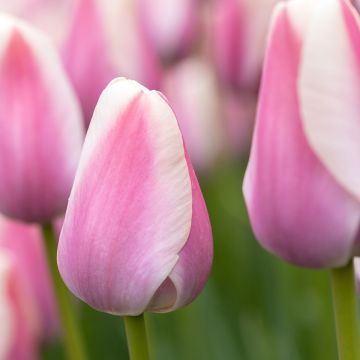
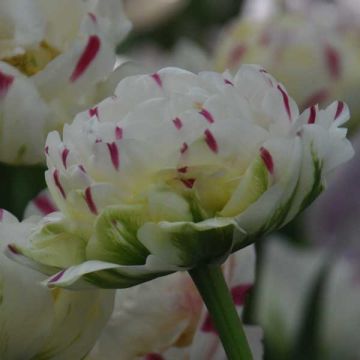
Comments